Optimal Wall Mounts for Heavy Pictures Explained
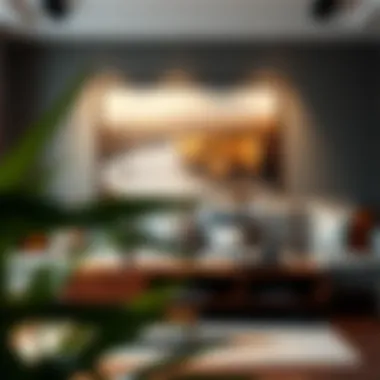
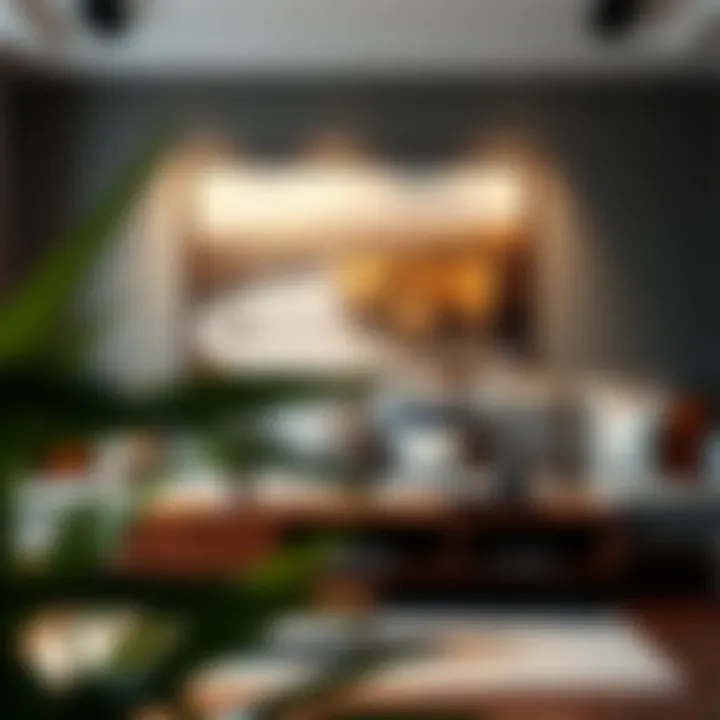
Intro
When it comes to displaying cherished artwork or heavy family photos, choosing the right wall mount cannot be overstated. A careless selection can not only lead to expensive damage but can also put your prized possessions at risk of crashing down. Imagine coming home after a long day only to find your massive oil painting dangling precariously or, worse, shattered into pieces on the floor. To navigate this precarious territory, it’s essential to understand the types of mounts available, the methods of installation, and how to ensure that your walls are equipped to handle the weight.
This guide intends to provide you with the necessary knowledge to make informed decisions regarding wall mounts for heavy pictures. From assessing wall structures to selecting materials that marry safety with aesthetics, you will gain insights that can help in not just securing your art but showcasing it in a manner that complements your living space. Whether you are a homeowner looking to enhance your environment or an interior designer curating the perfect ambiance, understanding wall mounts is crucial in elevating your décor game.
Let’s dive into this comprehensive exploration and equip you with everything you need to know, so you can confidently display your most treasured pieces without a second thought.
Understanding the Importance of Proper Mounting
Mounting pictures securely on walls might seem trivial, but it packs a punch in both safety and aesthetics. First off, when you hang a picture, you’re not just adding decor; you’re giving a piece of art its own space to shine. An optimal mount ensures that it holds its ground—literally. Understanding how to mount heavy pictures correctly can prevent significant damage to your walls, your art, and, frankly, your sanity when things go wrong.
The Risks of Inadequate Wall Support
Let’s consider a scenario. You’ve found the perfect wall to display that hefty family portrait. You might think, "A little nail here will do the trick." But, hold your horses. Improper mounting can turn a delightful display into a disaster. If the weight exceeds the mount's capacity, the picture can crash down. Picture frames made of glass breaking on hard floors can be a traumatic sight.
- Heavy items can tear away drywall, leading to costly repairs.
- A neglected mount can result in the picture falling unexpectedly, potentially harming someone or damaging other items nearby.
- Over time, the stress on inadequate supports can cause them to fail, regardless of initial stability.
Inadequate wall support isn’t just a matter of aesthetics—it’s about safety. A well-secured mount stands the test of time, ensuring that your cherished pieces remain safely on display.
The Role of Aesthetic Value in Mount Selection
Selecting the perfect mount isn't solely a function of weight capacity; it's about achieving harmony with your overall decor. A wall mount can subtly elevate the aesthetic appeal of a room, acting as an unsung hero that enhances your space. Here are a few considerations:
- Compatibility with Decor: The right mount complements the style of the picture and the surrounding décor. For instance, sleek metal mounts suit modern art, while wooden mounts might resonate more with classic paintings.
- Visibility and Focus: An optimal mount draws attention to the picture itself. The key is to choose a style that supports the art without overshadowing it. A minimalist mount often directs the eye straight to the artwork, creating an effective focal point.
- Balance and Proportion: Consider the balance between the size of the picture and the mount. A heavy picture deserves a sturdy yet refined mount that doesn’t seem out of place.
A well-chosen mount not only secures your valuable pieces but also enhances the visual impact they make within the space. Embracing the dual role of function and form ensures that your artwork can truly shine.
Types of Wall Mounts for Heavy Pictures
When it comes to displaying heavy pictures, selecting the right type of wall mount is crucial for both security and aesthetic appeal. The various options available come with their unique characteristics, advantages, and ideal use cases. An understanding of these types can greatly enhance the display of valuable artwork, ensuring they remain a focal point in your living space while also being safely secured.
D-Ring Hangers
D-ring hangers present a straightforward solution for mounting heavier frames. Typically made of metal, they are affixed to the back of the picture frame and allow it to hang securely on a single nail or screw. Here’s why they stand out:
- Simplicity: Their installation is as easy as pie—simply attach them to the frame and hang.
- Versatility: They work well for various wall types and can be adjusted to accommodate frame sizes.
- Affordability: Often found in hardware stores for a low price, D-ring hangers offer reliability without breaking the bank.
However, it is essential to keep in mind the weight capacity of the wall anchor used, as this method relies heavily on proper installation.
French Cleat Systems
French cleat systems take mounting to a whole new level. This two-part system consists of a horizontal board attached to the wall and a matching cleat on the back of the picture frame. Here are their key benefits:
- Stability: This system offers superior support. Since it distributes the weight across a larger surface area, it's ideal for oversized frames.
- Adjustability: You can easily slide the artwork up or down, allowing for precise leveling once installed.
- Clean Aesthetic: It provides a professional look, great for galleries and modern homes alike.
Though installation requires some careful measuring and leveling, the result is a robust and visually appealing mount.
Wall Brackets
Wall brackets offer a robust option for securely holding heavier pictures, especially those that may not work well with traditional hangers. These brackets are usually made from metal and are mounted directly onto the wall. Consider the following:
- Durability: Metal brackets are exceptionally strong and, when installed correctly, offer a high weight capacity.
- Design Flexibility: Available in various styles, they can complement both classic and contemporary decor.
- Accessibility: They can hold pictures that are often moved or adjusted, providing a practical solution for changing displays.
Bear in mind that the aesthetics of visible brackets might not suit every style, so careful selection is crucial.
Toggle Bolts
Toggle bolts are a reliable option when mounting pictures on drywall without the presence of studs. They consist of a screw with a toggle that opens inside the wall after being inserted. Consider these points:
- Strong Support: Ideal for heavy loads, toggle bolts can hold considerable weight—perfect for larger pieces or framed art.
- Wide Applicability: They can be utilized in various wall constructions, particularly drywall, where traditional mounting might not work.
- Ease of Use: Installation can be a bit tricky for the inexperienced, but they offer a dependable solution once you get the hang of it.
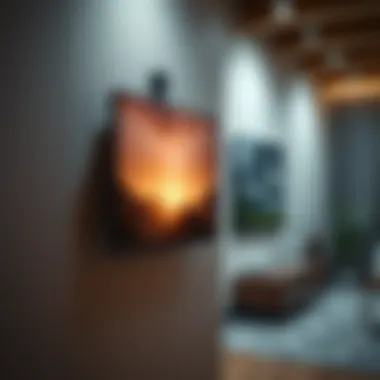
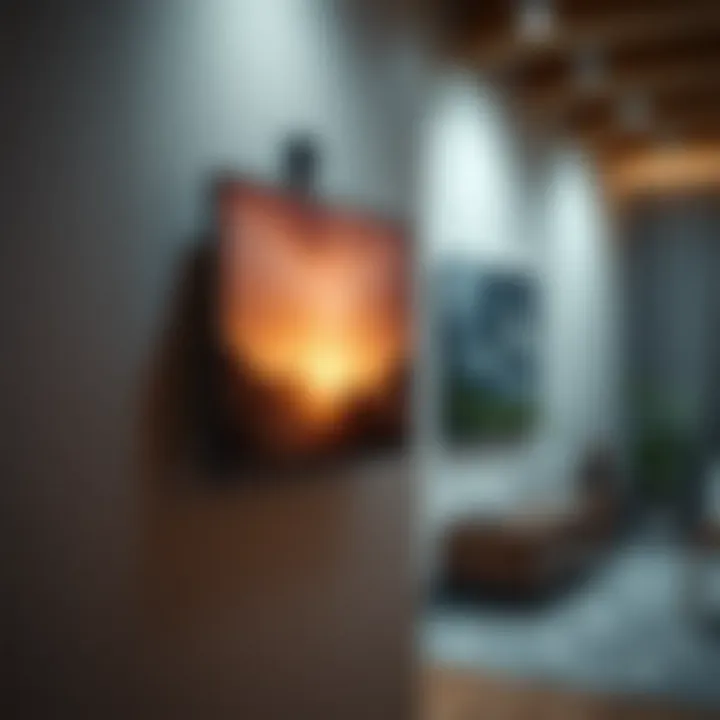
A potential downside is that you might need to patch walls if you remove the toggles, so think ahead.
"Choosing the right wall mount can mean the difference between an art piece displaying beautifully and a disaster waiting to happen."
Materials Considerations for Wall Mounts
When it comes to hanging heavy pictures, the choice of materials is pivotal. The kind of wall mount you select can dictate not only how secure your artwork is but also how well your decor integrates into your living space. Let's delve deeper into the differences between metal and plastic mounts, as well as the significance of understanding weight ratings.
Metal vs. Plastic: Pros and Cons
Choosing between metal and plastic for wall mounts often boils down to durability versus versatility.
Metal mounts, like steel or aluminum, provide unparalleled strength. They can safely support heavy frames that weigh a ton. Metal's resistance to bending or breaking means once secured, your artwork is there to stay; it avoids the wear and tear that can come from inexpensive solutions. However, the downside to metal is that it can be more expensive, and sometimes its installation can require advanced tools or skills.
On the other hand, plastic mounts tend to be lighter and more user-friendly. At a glance, these mounts can hold quite a bit; the trick is to ensure they are rated for the weight they’re expected to carry. Commonly used in home settings, plastic mounts might not offer the same longevity or security as their metal counterparts. They can be prone to cracking or deforming over time, especially under heavy loads.
Pros and Cons Summary:
- Metal:
- Plastic:
- Pros:
- Cons:
- Robust and durable.
- Long-lasting under stress.
- Better for heavy items.
- Can be pricier.
- May require specific tools for installation.
- Pros:
- Cons:
- Lightweight and easy to install.
- Generally more affordable.
- Less durable under heavy loads.
- Can degrade or break over time.
Weight Ratings and Their Importance
Understanding weight ratings is not just trivial; it's essential for the security of any artwork you hang. Each wall mount comes with a specific weight capacity, which should be adhered to meticulously. Imagine hanging a cherished heirloom family portrait only for it to crash down because the mount wasn’t up to the task.
Weight ratings ensure that:
- You select appropriate mounts according to the weight of the frames or artwork.
- The stability of your mounting solution allows for peace of mind.
"A chain is only as strong as its weakest link."
For heavy items, always opt for mounts that offer a higher weight capacity than your total picture weight to allow for fluctuations or shifts, like wall movements over time. Light mounts can be rated for lower weights, which works for smaller artwork, but for larger, weightier options, don’t skimp on quality.
Properly assessing the weight rating translates into fewer accidents, less wear and tear on your walls, and overall satisfaction with your wall-mounted displays. So don’t just take a wild guess; check the numbers.
Keeping these materials considerations front and center can make all the difference in how you enjoy your precious artwork for years to come.
Assessing Your Walls for Heavy Picture Mounting
Assessing your walls plays a pivotal role in the mounting of heavy pictures. Many homeowners rush into hanging their cherished artwork without giving a second thought to what lies beneath the surface. Understanding the structural integrity of your walls can sometimes make or break the display setup, protecting both the artwork and your living space.
Identifying Wall Types
When it comes to selecting the right wall mounts, distinguishing between wall types is essential. Each wall material presents its own set of unique features that can significantly impact how you go about securing your pictures.
Drywall
Drywall is a common material found in many homes and has a key characteristic of being lightweight and easy to install. Its appeal lies in its smooth surface, which supports a variety of decorative elements. However, when dealing with heavy pictures, certain drawbacks emerge. The weakness of drywall lies in its inability to bear heavy loads without the right anchors or studs behind it. If not supported correctly, a heavy piece can lead to a 'crash' moment that few would want to witness. For common mounting, consider using toggle bolts or anchors designed for drywall to ensure additional support.
Concrete
Concrete walls offer an entirely different ballgame in terms of strength and stability. They stand out for their durability and weight-load capacity, making them a superior option for heavy pictures. Nevertheless, the trick lies in the installation process. Drilling into concrete requires special tools that can be a hassle for the average DIYer. While you may find concrete to be robust, you also face the challenge of ensuring accurate placement and the right type of anchors to secure your mounts effectively.
Brick


Brick walls carry a rustic charm that many seek out for their homes. With a high compressive strength, brick can capably support heavy artwork like no other. However, the downside of brick is its irregular surface, which calls for specific mounting solutions.
You often need to use masonry screws or special anchors, both of which can drive up installation time and effort. With careful assessment, though, brick can serve as an ideal backdrop for art displays, allowing for a timeless aesthetic.
Plaster
Plaster walls, although somewhat less common today, still hold their ground in many older homes. They are known for their tactile texture and rich aesthetic appeal. However, plaster can feel like a double-edged sword; it offers aesthetically pleasing finishes, yet it can crack easily if heavy mounts are misused. When dealing with plaster, be sure to identify whether you are working with lath or solid plaster for proper anchoring. Inappropriate mounting options could lead not just to damaged artwork but also a ruined wall.
Stud Location and Anchor Points
Beyond the wall type, understanding stud locations is equally vital for supporting heavy pictures. The bravest among us don't always land a win when guessing the right spots and often end up regretting amateur tactics like nailing into random sections. It’s all about knowing where the strength in your wall lies.
Studs usually run horizontally at 16-inch or 24-inch intervals in drywall, providing natural anchor points. If you are working with other materials, take extra care to assess the layout.
In summary, taking the time to accurately assess your walls offers significant benefits in mounting heavy pictures. It can lead to the successful display of your cherished art without compromising safety or aesthetics.
Effective Installation Techniques
Effective installation techniques are crucial when mounting heavy pictures. The methods and tools you use play a significant role in ensuring that the artwork not only looks great but is also securely attached to your walls. Nobody wants to invest time and money into beautiful pieces just to have them fall and suffer damage. With the right approach, the entire process can be straightforward, safe, and satisfying.
Understanding the factors that contribute to successful installation can save you from headaches down the line. Not just any mount will suffice; one has to consider wall type, weight capacity, and the specific nature of the artwork. Integrating these considerations into your installation strategy will keep your art safe while enhancing the overall aesthetic of your space.
Tools You Will Need
To perform a successful installation, certain tools are indispensable. Having the right equipment on hand can make the job easier and increase accuracy. Here’s a rundown of what you’ll require:
- Drill and Drill Bits: A power drill will ensure that you can create holes precisely where you need them. Make sure to have various sizes of drill bits on deck to accommodate different anchors and screws.
- Stud Finder: This tool makes it easier to locate the wall studs. Studs provide the best support for heavy items.
- Level: An essential for ensuring everything is straight and aligned.
- Measuring Tape: This helps with spacing and placement.
- Pencil or Marker: For marking spot on the wall.
- Screwdriver: A good screwdriver can make a world of difference when securing your mounts.
- Wall Anchors: Depending on your wall type, having the appropriate anchors to provide more strength is key.
With these tools at your fingertips, you’re already gearing up for a smooth operation.
Step-by-Step Mounting Process
Now that you’ve gathered your tools, it’s time to roll up your sleeves and get to work. The process of mounting heavy pictures may vary slightly depending on the mount type but generally follows these key steps:
- Select the Right Location: Consider the design of the room and the visibility of your pictures. Think about lighting and how the picture will be viewed from various angles. Mark the desired spot lightly on the wall.
- Find the Studs: Using your stud finder, locate where the studs are in your wall. Mark these spots. If you are mounting on drywall and can’t hit a stud, you should ensure the anchors are rated for the weight you'll be hanging.
- Measure and Mark: Use your measuring tape to determine the ideal placement for your picture. Make sure to account for the height and width of the artwork and any additional spacing needed.
- Drill Holes: With your drill and the appropriate bit, drill holes at the marked locations. If using wall anchors, follow the instructions for those to make sure they’re installed correctly.
- Mount the Hardware: Attach the wall mount or brackets according to the instructions provided with your particular mount. Ensure all screws are tightened securely.
- Hang Your Picture: Carefully hang your artwork onto the mount. Use the level to double-check alignment.
- Final Check: Step back and assess the positioning. Make any small adjustments if necessary. Check that the brackets or mounts are secure and that everything is safe.
Following these steps will not only help ensure your artwork is secure but will also give you peace of mind when stepping back to admire your hard work.
Remember, taking your time during installation can save you from potential future mishaps.
For more detailed information on equipment and techniques, you can explore resources like Wikipedia on home improvement techniques, or join discussions on Reddit.
Ensuring your heavy pictures are safely mounted will drastically enhance your living spaces and protect your cherished pieces.
Decorative Options for Mounting Solutions
When it comes to hanging heavy pictures, many folks often overlook the aesthetic aspects of mounting solutions. \nThe choice of mount can greatly influence not only the safety of your artwork but also its overall appeal within your space. Decorative options are not just about function; they can also enhance the visual narrative of your room, seamlessly blending the practical with the artistic. For anyone passionate about interior design, understanding these decorative choices is essential to creating a cohesive look that reflects individual style while safely showcasing precious artwork.
Enhancing Aesthetic Appeal with Custom Mounts
Custom mounts offer an intriguing way to elevate the visual impact of your artwork. Rather than relying on stock solutions, a tailor-made mount can complement the unique features of your photograph or painting. Think of how a beautiful frame might enhance a stunning canvas; the same principle applies to the mounts themselves.
- Design Harmony: Selecting mounts that align with the colors and textures of your space can create a sense of cohesion. For instance, a sleek metal mount may work well in a modern setting, while a more ornate wooden mount could suit traditional decor.
- Personal Touch: You might want to opt for mounts that showcase personal preferences; for instance, certain themes—like rustic or minimalist designs—can add a unique flair to your collection.
- Concealment Features: A custom mount can also serve to subtly conceal hardware. This can allow the artwork and the mount to work together rather than compete for attention.
Visually, the artwork is often the star of the show, but the right mount can bring it to life, adding depth while ensuring it’s secure and stable. A well-chosen mount can often transform the way light interacts with the piece, creating an inviting atmosphere around it.
Incorporating Lighting and Props
Another key aspect of decorative mounting solutions lies in the inclusion of lighting and props. Lighting doesn’t just illuminate art—it can add mood and emphasis, turning a simple display into a dynamic experience.
- Accent Lighting: Using spotlights aimed at the picture can create dramatic shadows and highlight textures that may go unnoticed in regular lighting. This adds a layer of sophistication to the display, making it firm and engaging.
- Adjustable Features: Some modern mounts even allow for the integration of adjustable lighting, enabling you to shift the angle of the light to suit different times of day or mood settings.
- Props and Context: You may also want to consider placing related props around the mounted picture. Whether it’s a complementary sculpture or a themed shelf beneath the artwork, these additions can enhance the overall story you’re telling with your decor.
Custom mounts and strategic lighting can take heavy pictures from mere decor to highlight pieces, drawing the eye and elevating the overall vibe of your space.
In essence, decorative solutions for mounting heavy pictures are a blend of creativity and practicality. By prioritizing both aesthetic and functional elements, you can create a visually stunning and secure display that transforms your interior environment into something truly unforgettable.
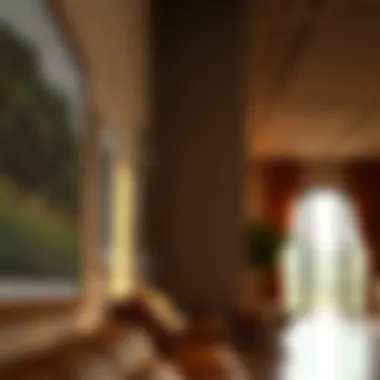

Maintaining and Caring for Heavy Wall-Mounted Pictures
Caring for heavy wall-mounted pictures goes beyond simple aesthetics; it’s about ensuring the longevity and security of your valued artwork. Whether it's a family portrait or a prized painting, proper maintenance will not only enhance the appearance of your space but also protect your investment.
Periodic Checks for Security
One of the primary aspects of maintaining wall-mounted pictures is regular security checks. Over time, mounts can loosen due to vibrations, changes in humidity, or the natural settling of your home’s structure.
To avoid any mishaps, set a reminder to check the security of your mounts at least twice a year. Here are a few things you can look for during your checks:
- Tightness of Mounts: Ensure the screws and brackets are securely fastened. If anything feels loose, re-tighten it.
- Wall Condition: Inspect your walls for any signs of warping or cracking, indicating shifts in structure.
- Weight Distribution: If you’ve added additional items nearby, ensure that the combined weight doesn’t affect the mounting integrity.
- Picture Alignment: Occasionally, heavy frames may shift, resulting in misalignment. This doesn’t just impact aesthetics; it can lead to stress on the mounting hardware.
"Regular checks are like routine maintenance for your best pieces — they ensure that both art and mount do their job without drama."
Cleaning Tips for Artworks
While security is crucial, keeping your art clean can greatly prolong its life. Dust and dirt can accumulate, obscuring the beauty of your pieces. Here are a few tips to care for and clean your wall-mounted pictures:
- Gentle Dusting: Use a soft, lint-free cloth or a microfiber duster to lightly wipe down the frame or glass. Avoid using feathers, as they might scratch surfaces.
- Cleaning Solutions: If you're dealing with glass, a mixture of water and a few drops of mild dish soap can work wonders. Just ensure the cloth is damp, not soaking, to avoid any drips that might harm the wall.
- Avoid Harsh Chemicals: Stay clear of abrasive cleaners or chemicals, which can damage antique frames or specialty glass. If you’re unsure, test your cleaner on a small, inconspicuous area first.
- Regular Schedule: Just as you would with security checks, create a schedule for cleaning; reducing accumulated dust makes the process easier and more effective.
By investing time and care into maintaining and cleaning your heavy wall-mounted pictures, you're not just protecting your artwork but also enhancing the overall aesthetic and functionality of your living space. Take pride in your collection, while ensuring everything stays just where it should be.
Common Mistakes to Avoid
When it comes to mounting heavy pictures, many people often rush into the process without thoroughly considering their options. Avoiding common mistakes can make all the difference in ensuring that your beloved artwork not only looks great but also remains securely in place. Here, we will highlight two significant pitfalls that homeowners and interior designers frequently encounter when selecting and installing wall mounts for heavy pictures.
Underestimating Weight Capacity
One of the most frequent errors people make is underestimating the weight capacity of the mounts they plan to use. Picture mounts and wall anchors are not created equally; each type has a specific weight limit based on its design and material.
It's all too easy to assume that a mount rated for a certain weight can handle just a bit more. This is a risky mindset, especially when dealing with artwork that can often exceed the expected weight due to heavy frames or protective glass. A better approach is to double-check the specifications of your chosen mount and consider the actual weight of the art plus any added components. Additionally, remember to factor in a safety margin. If a picture is rated at 20 pounds, consider choosing a mount rated for 30 or even 40 pounds to ensure it's equipped to handle any surprises.
"Always better to overestimate than to look at a mishap on the floor once the picture comes crashing down."
To avoid such mishaps, here are a couple of tips:
- Know the actual weight of your picture: Use a scale to weigh the piece accurately.
- Research various mounting options: Some mounts are designed for heavier loads, such as industrial-strength wall brackets or French cleat systems.
Ignoring Wall Structure
Another common slip-up when it comes to mounting heavy pictures is ignoring the wall structure where they will hang. Different wall types—be it drywall, concrete, brick, or plaster—each present unique challenges and opportunities regarding what kind of mounts to use. Failing to take these structural differences into account can mean the difference between a stunning display and a disastrous crash.
For example, drywall is often not strong enough by itself to hold heavy artwork securely. It typically requires additional support from wall studs or specialty anchors designed for drywall. Meanwhile, concrete or brick walls may allow for direct installation, but they still need proper anchors to avoid smudging your fine walls with an ill-placed drill hole.
To avoid these pitfalls:
- Analyze the wall type: Before starting your mounting project, gauge what material you’re working with.
- Choose suitable mounts: Each wall type will likely recommend different types of mounting hardware. Look for detailed specs to guide your choice.
In summary, being mindful of both the weight capacity of your mount and the wall structure will save you from potential troubles down the line. This preparation ultimately leads to a more appealing and secure display that showcases the beauty of your heavy pictures without compromise.
Epilogue: The Art of Secure Display
Once all is said and done, the importance of mounting heavy pictures correctly cannot be underscored enough. Secure displays not only ensure that your treasured artworks remain exactly where they belong, but they also add to the overall ambiance of a room. A well-hung picture can transform a dull space into a gallery-like atmosphere. The careful consideration of the right wall mount, installation technique, and ongoing maintenance plays a monumental role in achieving that end.
Recap of Key Considerations
To recap, let's hit the main points:
- Proper Wall Mount Selection: Different wall mounts are designed for specific weights and wall types. Whether choosing D-Ring hangers or a French cleat system, the right fit is critical.
- Assessing Wall Structure: Not all walls are created equal. For instance, mounting on plaster may require different precautions compared to drywall or concrete. Knowing the wall type informs the appropriateness of mounting options.
- Installation Techniques: Mastering the tools and methods involved in installation can't be overlooked. It’s as much about how you hang as what you choose.
- Aesthetic Integration: A mount should not just serve a functional purpose; it should harmoniously blend with your decor, enhancing your artistic expression and style.
Final Thoughts on Choosing Wall Mounts
As you embark on the journey of selecting the ideal wall mounts for your heavy pictures, consider it a blend of art and science. The actual mounting is a technical endeavor, yet the choices you make across styles and materials should also resonate with your personal aesthetic. Don’t just focus on what looks good; ensure that what you choose can support the weight and structure of your decor items.
In summary, be mindful and deliberate. Making informed decisions will not only protect your artwork but also create captivating spaces within your home. It's a balance of form and function, where art meets structural integrity. If you keep these considerations in your mind, you'll be assured that your valuable pieces will both shine and stand the test of time.
"Art is not what you see, but what you make others see." – Edgar Degas
By adhering to the insights gleaned from this article, you are well on your way to becoming a savvy curator of your environment, adept at blending practicality with visual appeal. Remember, a well-executed display isn't merely about hanging something on the wall; it’s about crafting an experience that resonates with anyone who steps into your space.















